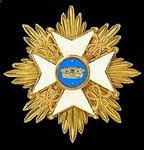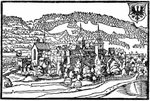Originally of one battalion. Ranked 108th in 1753 but 110th in 1759.
First raised by the Prince of Nassau-Saarbrück 1st November 1745. The Prince had asked for the commission on behalf of his son Louis who was still too young and obtained a brevet the 4th February 1746 to command the regiment until his son was of age.
The regiment first saw action in 1746 at the sieges of Mons and Charleroi. It covered the operations of the siege of Namur and was then at the battle of Rocoux. On the 1st July 1747 it was at the battle of Lauffeld and increased to 3 battalions by an order of that date. In 1748 it was before Maastricht with Alsace. An Ordonnance of 1st February 1749 reduced it to two battalions.
In 1757 the regiment was ordered to join the Army of Germany. It arrived in Cologne at the end of April, fought at Hastenbeck and then went to Hanover with Marshal de Richelieu. It assisted in the taking of Minden and Hanover and then took part in the expeditions sent to Closterseven and Zell. Returning to the Rhine at the beginning of 1758, it stayed at Cologne where it was incorporated, by an Ordonnance of 20th March, with the regiment of Nassau-Usingen. That regiment, which had also been created on the 1st November 1745, but which had seniority, formed the 1st battalion of the new unit, whose command was given to Prince Louis of Nassau-Saarbrück, and took the title of Nassau.
Nassau remained at Cologne the whole of the 1758 campaigning season. The following year [1759] it was at the battle of Bergen in the ranks of the reserve. Raised to 3 battalions on the 18th January 1760 by the incorporation of the German regiment of Saint-Germain, it took part in the campaign in Hesse and took up winter quarters in Ziegenheim. Attacked in the month of February 1761 in this town, which the Allies almost destroyed with red hot cannonballs, they successfully held the place for three weeks and gave time for Marshal de Broglie to come to their rescue. Their valour was crowned with success; the enemy decamped on the 25th February.
Nassau was also distinguished again that year at the battle of Vellinghausen. It was part of the advance guard brigade commanded by Monsieur de Clozen and captured three enemy cannon. Colonel-Commandant the Baron de Zügmantel was praised for his conduct. Lieutenant-Colonel Oëh was similarly praised for his conduct at the combat of Osterode on the 2nd September. In 1762 the regiment served in the defence of Cassel which capitulated on the 1st November. It returned to France and on the 21st December was reduced to two battalions. At the peace of 1763 the regiment went into garrison at Metz.
[The above is my translation of the account of the regiment's history 1745-1763 in Susane Volume 7.]
And this was the uniform according to the manuscript of 1757:






















